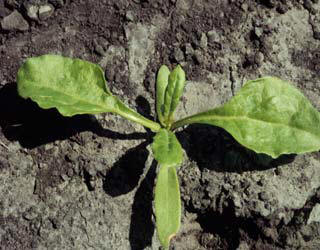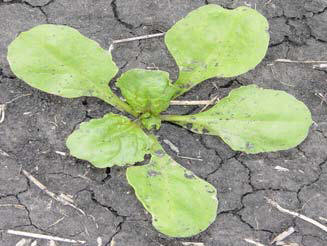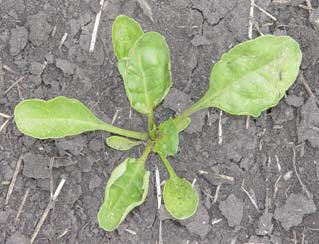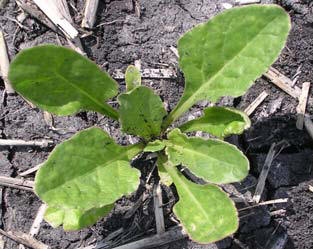Sugarbeets emerge from the soil with a pair of cotyledon leaves. These leaves will normally yellow and drop from the plant, usually by the fifth or sixth leaf stage. The next leaves to emerge from the crown are the first true leaves. Although these leaves appear simultaneously and seem to be oppositely arranged, they are alternate with one of the leaves developmentally behind the other. Stage separation between the first and second true leaves is not possible. All subsequent leaves emerge from the crown in an alternate pattern. The following table represents the staging system for the sugarbeet up to the nine-leaf stage. The staging method designates the leaf stages V 1.0 to V 9.0. Leaves are counted when the leaf blade is fully unrolled.
Stage Description
G Germination stages prior to emergence
V 1.0 Cotyledons emerged and no evidence of first or second leaf
V 1.1 Cotyledons and first and second leaf just visible
V 1.5 Cotyledons present and at least 50% of next leaves unrolled
V 1.8
V 1.9 Cotyledons present and at least 90% of next leaves unrolled, but not completely
V 2.0 Two leaves unrolled and third leaf not visible
V 2.1 Two leaves unrolled and third leaf just visible
V 2.5 Two leaves unrolled and third leaf at least 50% unrolled
V 2.6
V 2.9 Two leaves unrolled and third leaf 90% unrolled
Each subsequent leaf stage (V3.0 – V8.9) is described similarly. As crop development progresses beyond V2.0 leaf stage, two or more developing leaves are always present. Therefore, true V3.0, V4.0; etc. growth stages are not possible.
The system uses decimal fraction of each leaf stage to allow better separation between leaf stages and increase accuracy of GDD predictions. The decimal fractions are used to represent the percentage or amount of the next emerging leaf that has unrolled. For example, if a plant has three fully unrolled leaves and the fourth leaf is approximately 60 percent unrolled, the stage is V3.6. At later leaf stages when several unrolled leaves may be present, use the most advanced leaf of the recent emerged pair in the estimate; be sure to never count the cotyledons.
| V 3.8 | V 4.1 |
 |  |
| V 4.7 | V 5.7 |
 |  |
| V 6.3 | V 7.2 |
 |  |
| V 8.4 | |
 |
(*data obtained from American Crystal Sugar Company)





